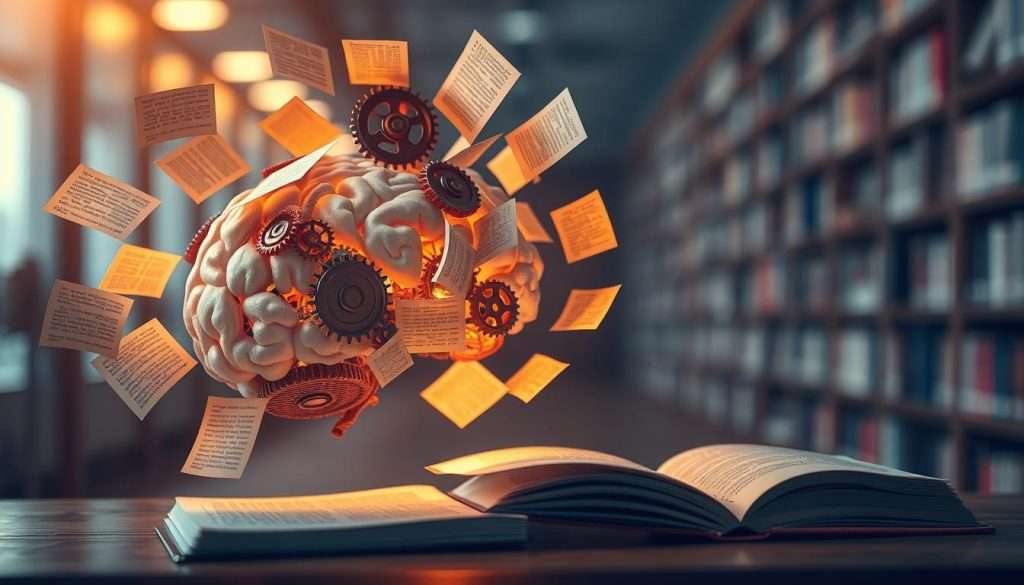Ever finish reading something and feel like you’ve learned nothing? You’re not alone! Forgetting what we read is a common problem. It happens when we don’t connect new info to what we already know.
Our brains don’t automatically file away what we read. Without making it relevant, the details disappear fast. That’s where encoding comes in – a key to better memory retention. By the end of this article, you’ll know how to keep more of what you read.
Key Takeaways
- Understand why you forget what you read
- Learn how encoding improves memory retention
- Discover practical strategies to make reading more effective
- Transform your reading experience with simple techniques
- Retain more information with minimal effort
The Science of Memory: How Your Brain Processes Reading
When we read, our brain goes through several steps to remember what we’ve read. Knowing these steps helps us understand and remember better.
The Three Stages of Memory Formation
Memory formation has three main stages: encoding, storage, and retrieval. Encoding is the first step, where our brain learns and organizes the information we read.
Encoding, Storage, and Retrieval Explained
Let’s look at each stage. Encoding is making a memory, storage is keeping it, and retrieval is getting it back when needed. Think of it like saving a document: encoding is typing, storage is saving, and retrieval is opening it later.
Why Encoding Is the Critical First Step
Encoding is key because it sets how we store and get back information. Good encoding helps us remember better.
What Happens in Your Brain When You Read
Reading makes our brain create paths for information. Knowing the difference between working and long-term memory is important for understanding and remembering.
Neural Pathways and Reading Comprehension
Neural pathways are like roads in our brain for information to travel. The more we read, the stronger these paths get.
Working Memory vs. Long-Term Memory
| Memory Type | Characteristics | Role in Reading |
|---|---|---|
| Working Memory | Limited capacity, temporary storage | Processes information in real-time |
| Long-Term Memory | Large capacity, long-term storage | Stores information for later retrieval |
Why You Forget What You Read (and How Encoding Fixes Everything)
Ever wondered why you forget what you read hours later? Forgetting what we read is common. Our brains handle lots of info, but keeping it is hard. The forgetting curve and encoding techniques help a lot with memory retention.
The Forgetting Curve Explained
The forgetting curve shows how our memory fades over time. Hermann Ebbinghaus first studied this. He found forgetting isn’t steady but gets faster.
Ebbinghaus’s Research and Modern Applications
Ebbinghaus’s work helped us understand forgetting. His ideas are used in effective learning strategies like spaced repetition. This method fights the forgetting curve.
The Exponential Nature of Forgetting
The forgetting curve shows forgetting happens fast at first. Then, it slows down. But, without practice, we lose a lot of info.
The Critical Role of Encoding in Memory Retention
Encoding is key to keeping info in our minds. Using encoding techniques makes info stick better. This boosts memory retention.
How Proper Encoding Flattens the Forgetting Curve
Good encoding makes info easier to remember. It makes the forgetting curve less steep. Making vivid mental images or associations helps a lot.
The Encoding-Retrieval Connection
There’s a strong link between encoding and recalling info. Good encoding makes it easier to remember later. This is crucial for learning.
Common Reasons Behind Reading Amnesia
Ever read a page and forget everything? You’re not alone. Many struggle to remember what they’ve read. Let’s look at why this happens.
Passive Reading: The Silent Memory Killer
Passive reading doesn’t engage our brains fully. It’s like watching TV – you’re not really participating. This makes remembering harder.
Signs You’re Reading Passively
- Your mind wanders while reading.
- You keep rereading the same paragraph.
- You can’t remember the main points after finishing a chapter.
The Attention-Memory Connection
Our focus is key to remembering. If we’re not fully engaged, we forget. It’s like trying to take a photo with a shaky hand – the picture will be blurry.
Information Overload and Cognitive Bandwidth
Our brains can only handle so much information at a time. Too much and we forget.
The Limits of Working Memory
Working memory is like RAM on your computer. It holds information temporarily. Too much and some data gets lost.
Context Switching and Memory Interference
Switching topics or sources while reading can mess with our memory. It makes remembering harder.
Lack of Contextual Understanding
Understanding the context is key to remembering. Without it, information stays abstract and hard to recall.
The Importance of Background Knowledge
Relevant background knowledge helps us understand and remember new information. It creates a framework for new ideas.
How Context Creates Memory Hooks
Context gives us memory hooks – mental anchors for remembering. The more we understand, the more hooks we have.
By tackling passive reading, information overload, and lack of context, we can improve our reading retention.
The Encoding Advantage: How It Transforms Information Retention
Ever wondered why some info sticks in your memory while others disappear? The secret is encoding, a key process for keeping new info in mind.
What Is Encoding and Why It Matters
Encoding is learning new info, and it’s vital for remembering it later. By using different encoding types, like semantic, visual, and acoustic, we boost our memory.
Different Types of Encoding
Semantic encoding is about understanding the info’s meaning. Visual encoding uses images. Acoustic encoding focuses on sounds. Mixing these methods strengthens our memory.
How Multiple Encoding Pathways Strengthen Memory
Engaging multiple senses and encoding types creates more brain connections. This makes it simpler to remember info later.
The Neuroscience Behind Effective Encoding
Learning about encoding’s neuroscience shows us the brain’s role and how it can get better at memory. Good encoding uses various brain parts, like those for attention and emotion.
Brain Regions Involved in Successful Encoding
| Brain Region | Function |
|---|---|
| Hippocampus | Formation of new memories |
| Prefrontal Cortex | Attention and decision-making |
| Amygdala | Emotional processing |

Neuroplasticity lets our brain adapt and improve, enhancing our encoding and memory over time. By using this flexibility, we can create better encoding strategies for better memory.
Fundamental Encoding Techniques for Better Reading Retention
To really remember what you read, you need to do more than just read. You must actively engage your brain with encoding techniques. This isn’t just about getting the text; it’s about making it stay in your memory. Let’s look at some basic strategies to boost your reading retention.
How to Implement Active Reading Strategies
Active reading is key to effective encoding. It means being an engaged reader who interacts with the material. Two great ways to do this are through annotation and note-taking.
Annotation Methods That Enhance Memory
Annotating as you read has many benefits. It makes you focus more, understand better, and remember more. Try underlining key points, circling important terms, and writing notes in the margins.
The Cornell Note-Taking System for Readers
The Cornell Note-Taking System is a structured method that works well for readers. It divides your paper into two columns – one for notes and one for summaries and questions. This system encourages active engagement and helps in reviewing the material later.
Creating Powerful Visualizations While Reading
Visualizing what you read is another effective encoding technique. By creating mental images, you’re adding another layer of memory that can aid recall.
Step-by-Step Mental Image Creation
To create mental images, start by identifying key concepts or scenes in the text. Then, visualize these in your mind, adding as much detail as possible. The more vivid and unusual the image, the better it will stick.
Connecting Abstract Concepts to Visual Anchors
For abstract concepts, try to connect them to something tangible or visual. For example, if you’re reading about a complex theory, imagine it as a machine or a structure that you can see and manipulate in your mind.
Practicing Elaborative Interrogation Techniques
Elaborative interrogation involves asking questions about the material you’re reading and then answering them. This technique enhances understanding and retention.
Essential Questions to Ask While Reading
As you read, ask yourself questions like “What is the main idea here?”, “Why is this information important?”, or “How does this relate to what I already know?”
Transforming Answers into Memory Anchors
The answers to these questions become memory anchors. By elaborating on the information and connecting it to your existing knowledge, you’re making it easier to recall later.
By adding these encoding techniques to your reading routine, you’ll see big improvements in retention and comprehension. It’s not just about reading more; it’s about reading more effectively.
Advanced Encoding Methods to Supercharge Your Reading Memory
To boost your reading memory, explore advanced encoding methods. These techniques make information more meaningful and easier to recall. They help you remember more of what you read.
Building Your First Memory Palace for Reading Material
The “memory palace” method, also known as the method of loci, is powerful. It involves visualizing a familiar place and linking information to specific spots in that space.
Selecting and Mapping Your Memory Locations
Start by choosing a place you know well, like your home. Imagine walking through it and pick distinct locations. Create a mental map of these spots in the order you want to visit them.
Placing Key Information in Your Memory Palace
After mapping your locations, link key information to each spot. For example, associate historical events with each location. The sillier or more vivid the image, the better it will stick in your memory.

Implementing Dual Coding for Complex Material
Dual coding combines verbal and visual information to enhance memory. It engages both your visual and auditory brain, creating a stronger memory of what you read.
Creating Visual Representations of Text
When reading complex material, create mental images that represent the information. For example, visualize the steps of a scientific process. Drawing diagrams or creating mind maps can also help.
Combining Verbal and Visual Elements Effectively
The key to dual coding is to blend verbal and visual elements seamlessly. For instance, associate a historical figure’s name with a visual image of their achievements or a significant event in their life.
Setting Up Your Spaced Repetition System
Spaced repetition reinforces memory over time. Review material at increasingly longer intervals to solidify it in your long-term memory.
Digital and Analog Spaced Repetition Options
You can use digital tools like flashcard apps or analog methods like physical flashcards for spaced repetition. The goal is to review material before you forget it, gradually increasing the time between reviews.
Optimal Scheduling for Different Types of Material
The best scheduling for spaced repetition varies by material type. Simple facts may need shorter intervals, while complex information may require longer intervals. Experiment to find what works best for you.
By using these advanced encoding methods, you can significantly improve your reading memory. Techniques like building a memory palace, using dual coding, or setting up a spaced repetition system can supercharge your reading memory.
Practical Implementation: Creating Your Encoding Routine
Let’s explore how to create an encoding routine that suits you. A consistent routine is key for improving memory and reading comprehension. Follow these steps to better retain information.
Step 1: Prepare Your Mind and Materials Before Reading
Before you start, prepare your mind and materials. This step is crucial for effective encoding.
Creating the Optimal Reading Environment
Find a quiet, comfy spot for reading. Make sure the light is right and the room is at a good temperature. A tidy workspace also helps focus.
Pre-Reading Techniques That Prime Your Brain
Start by skimming the table of contents or reading the intro. Browsing headings also helps. These steps prepare your brain for what’s to come.
Step 2: Engage Actively During the Reading Process
Being active while reading is key for encoding. It’s not just about reading; it’s about understanding and processing.
The Pause-and-Process Method
Pause often to summarize the main points in your words. This method strengthens your grasp and memory.
Immediate Application Techniques
Apply what you’ve read right away. For example, try out a new skill or technique. This practical use boosts your memory and comprehension.
Step 3: Consolidate Information After Reading
After finishing, it’s vital to solidify the information. This step ensures the knowledge stays with you.
The 24-Hour Review Strategy
Review the material within 24 hours. Go over your notes or the text again. This review strengthens your memory.
Creating Connection Maps Between Reading Sessions
For complex or long materials, make a map of connections. Visualizing these connections enhances understanding and retention.
By following these steps, you can improve your reading comprehension and memory through effective encoding techniques.
Overcoming Common Obstacles to Effective Encoding
The path to mastering encoding comes with its own set of challenges. But knowing these obstacles is the first step to beating them. As we dive into learning strategies and encoding methods, we must tackle common hurdles that slow us down.
Managing Digital Distractions During Reading
In today’s world, distractions are just a click away. To stay focused, we must manage these distractions well.
Technology Solutions for Focused Reading
Apps that block social media or track your reading can change the game. For example, apps like Freedom or SelfControl can keep you on track.
Creating Mental Boundaries for Deep Focus
Having dedicated time for reading and a good environment can also help. Choose a reading spot that’s free from distractions and interruptions.
Handling Information Overload With Chunking
Breaking down complex info into smaller chunks makes it easier to understand. This method is called chunking.
Breaking Complex Material Into Manageable Units
Find key concepts and break them into smaller, easier-to-digest pieces. This improves information retention.
Progressive Integration of Information Chunks
Slowly connect these chunks to get a full understanding of the material. This boosts memory retention.
Building Consistent Encoding Habits
Consistency is crucial for making encoding a habit. Track your practice and tweak techniques as needed.
Tracking Your Encoding Practice
Keep a journal or log to track your progress. This helps you see what works best for you.
Adjusting Techniques Based on Material Type
Be flexible with your encoding methods. Different materials need different approaches.
Conclusion: Transforming Your Reading Experience Through Encoding
We’ve looked into why forgetting what we read happens and how encoding can change the game. By grasping the science of memory and using effective encoding methods, you can keep more information. This makes it easier to understand complex texts.
Encoding isn’t just one trick; it’s a variety of strategies for different reading needs. You can try active reading, visualization, or even memory palaces and spaced repetition. There are many tools to help you.
Now, it’s time to use these strategies in your reading. Start with one or two techniques each day. As you get better, add more to your collection. This will make reading more fun, effective, and rewarding.

